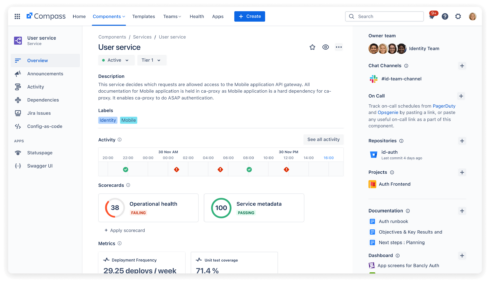
Atlassian today is announcing the general availability of Compass, the company’s new developer experience platform.
With developers getting lost in today’s decentralized, complex world of APIs, libraries, UI elements, frameworks and tools, Compass is designed to guide developers to their true north – delivering exciting new products that align with business goals and satisfy customers.
According to Taylor Pechacek, Atlassian’s head of product for Compass, developers need to navigate through this ocean of complexity to find the information and context they need around the work they’re doing, and to collaborate across the tech stack to make sure the software is kept in a healthy state.
So this, he said, is not just a technology problem, but very much a collaboration problem.
Pechacek explained that Compass improves the developer experience by creating a single, reliable and standardized place to capture all the context around the code. “There’s all these different software components out there, so an individual service is not just its code anymore. It has dashboards and observability. It has security issues coming in against it, it has compliance that the organization needs to stay on top of.”
What they’re going to be able to do with Compass, he explained, is that they’re going to be able to empower developers to work autonomously. “They’re going to be able to increase overall engineering velocity by spotting those outliers. They’re going to be able to improve reliability, because developers and those teams understand how those pieces fit together.”
Pechacek noted there are four key default features in the Compass release. The first is a unified software component catalog to help users track all their services and relevant data and untangle their technical architecture all in one place. “Where is that run book?” Pechacek cited. “Which Slack channel do I actually contact? What is the latest deployment of this? Developers are going to be able to reduce time spent searching for this information, and they’re going to be able to get back into that flow state faster.”
The catalog is being made available for free to Atlassian customers.
The second are health scorecards that help organizations track delivery and team health metrics to “identify points of friction for development teams and improve reliability for existing services,” Atlassian announced.
As Pechacek explained, “Once you have a consistent model of those components there, you can establish and evaluate the health of the company’s architecture and the team health. How do I keep all of my critical services secure?” The scorecards, he said, make it easy to monitor that progress. And if there are any regressions in the architecture health, such as having too many open security vulnerabilities, or incidents are eating up too much of your sprint, he added that “you can accelerate those feedback loops so that developers are not being interrupted by these apps coming across the business, and they’re able to get back to fulfilling more complex challenges for their team.”
The third foundational component of Compass is templates. Pechacek explained that whether they’re creating a new service or a new library, developers often have to go through hours of configuration and library setup just to be able to write a piece of code. With the templates included in Compass, the organization can bake in best practices and enforce consistency. “So when a developer says, ‘Yeah, I need a new back end service to build my feature,’ that’s a one-click experience for them,” he said. “Essentially, they get all the infrastructure, they get their pipeline, they get the libraries that the company wants to give them, all the configuration settings and so forth. This is the happy path… and will help developers get started very quickly.”
The final piece is around extensibility, with Compass “being able to bring together information scattered across the organizations’ toolchain and ties it to relevant services and teams,” Atlassian wrote in its announcement blog.
Compass allows development organizations to integrate across their existing tool chain, and to interact with that data. Pechacek notes that Atlassian’s APIs are free and accessible, and developers can collaborate with access to that information, coming from code, coming from CI/CD and observability, and take that information from Compass and put that back into other tools. “So now, my scorecards are part of my Jira Software sprint, to know how to prioritize technical debt versus innovation and new features,” he said.
Want to learn more about making developers more productive? Join us at Improve: Productivity, a one-day virtual event on Nov. 15. Learn more here.






